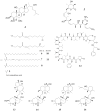Marine natural products with P-glycoprotein inhibitor properties
- PMID: 24451193
- PMCID: PMC3917285
- DOI: 10.3390/md12010525
Marine natural products with P-glycoprotein inhibitor properties
Abstract
P-glycoprotein (P-gp) is a protein belonging to the ATP-binding cassette (ABC) transporters superfamily that has clinical relevance due to its role in drug metabolism and multi-drug resistance (MDR) in several human pathogens and diseases. P-gp is a major cause of drug resistance in cancer, parasitic diseases, epilepsy and other disorders. This review article aims to summarize the research findings on the marine natural products with P-glycoprotein inhibitor properties. Natural compounds that modulate P-gp offer great possibilities for semi-synthetic modification to create new drugs and are valuable research tools to understand the function of complex ABC transporters.
Figures






Similar articles
-
Natural Products as Alternative Choices for P-Glycoprotein (P-gp) Inhibition.Molecules. 2017 May 25;22(6):871. doi: 10.3390/molecules22060871. Molecules. 2017. PMID: 28587082 Free PMC article. Review.
-
Overcoming multidrug resistance in human cancer cells by natural compounds.Toxins (Basel). 2010 Jun;2(6):1207-24. doi: 10.3390/toxins2061207. Epub 2010 May 28. Toxins (Basel). 2010. PMID: 22069634 Free PMC article. Review.
-
Marine Natural Products as Models to Circumvent Multidrug Resistance.Molecules. 2016 Jul 8;21(7):892. doi: 10.3390/molecules21070892. Molecules. 2016. PMID: 27399665 Free PMC article. Review.
-
Structural and functional aspects of P-glycoprotein and its inhibitors.Life Sci. 2018 Dec 1;214:118-123. doi: 10.1016/j.lfs.2018.10.048. Epub 2018 Oct 27. Life Sci. 2018. PMID: 30449449 Review.
-
Potential of Natural-Based Anticancer Compounds for P-Glycoprotein Inhibition.Curr Pharm Des. 2018;24(36):4334-4354. doi: 10.2174/1381612825666190112164211. Curr Pharm Des. 2018. PMID: 30648503 Review.
Cited by
-
ABC Transporters at the Blood-Brain Interfaces, Their Study Models, and Drug Delivery Implications in Gliomas.Pharmaceutics. 2019 Dec 23;12(1):20. doi: 10.3390/pharmaceutics12010020. Pharmaceutics. 2019. PMID: 31878061 Free PMC article. Review.
-
Natural Products as Alternative Choices for P-Glycoprotein (P-gp) Inhibition.Molecules. 2017 May 25;22(6):871. doi: 10.3390/molecules22060871. Molecules. 2017. PMID: 28587082 Free PMC article. Review.
-
Iso-pencillixanthone A from a marine-derived fungus reverses multidrug resistance in cervical cancer cells through down-regulating P-gp and re-activating apoptosis.RSC Adv. 2018 Dec 10;8(72):41192-41206. doi: 10.1039/c8ra09506j. eCollection 2018 Dec 7. RSC Adv. 2018. Retraction in: RSC Adv. 2025 Jan 9;15(1):712. doi: 10.1039/d5ra90002f. PMID: 35559314 Free PMC article. Retracted.
-
Phytol and Heptacosane Are Possible Tools to Overcome Multidrug Resistance in an In Vitro Model of Acute Myeloid Leukemia.Pharmaceuticals (Basel). 2022 Mar 15;15(3):356. doi: 10.3390/ph15030356. Pharmaceuticals (Basel). 2022. PMID: 35337153 Free PMC article.
-
A Rare Class of New Dimeric Naphthoquinones from Diospyros lotus have Multidrug Reversal and Antiproliferative Effects.Front Pharmacol. 2015 Dec 16;6:293. doi: 10.3389/fphar.2015.00293. eCollection 2015. Front Pharmacol. 2015. PMID: 26732580 Free PMC article.
References
-
- Sharom F.J. Multidrug Resistance Protein (P-Glycoprotein; MDR1) In: You G., Morris M.E., editors. Drug Transporters: Molecular Characterization and Role in Drug Disposition. John Wiley & Sons; Hoboken, NJ, USA: 2007. pp. 223–262.
-
- Bansal T., Jaggi M., Khar R.K., Talegaonkar S. Emerging significance of flavonoids as P-glycoprotein inhibitors in cancer chemotherapy. J. Pharm. Pharm. Sci. 2009;12:46–78. - PubMed
-
- Cordon-Cardo C., O’Brien J.P., Casals D., Rittman-Grauer L., Biedler J.L., Melamed M.R., Bertino J.R. Multidrug-resistance gene (P-glycoprotein) is expressed by endothelial cells at blood-brain barrier sites. Proc. Natl. Acad. Sci. USA. 1989;86:695–698. doi: 10.1073/pnas.86.2.695. - DOI - PMC - PubMed
Publication types
MeSH terms
Substances
LinkOut - more resources
Full Text Sources
Other Literature Sources
Miscellaneous

